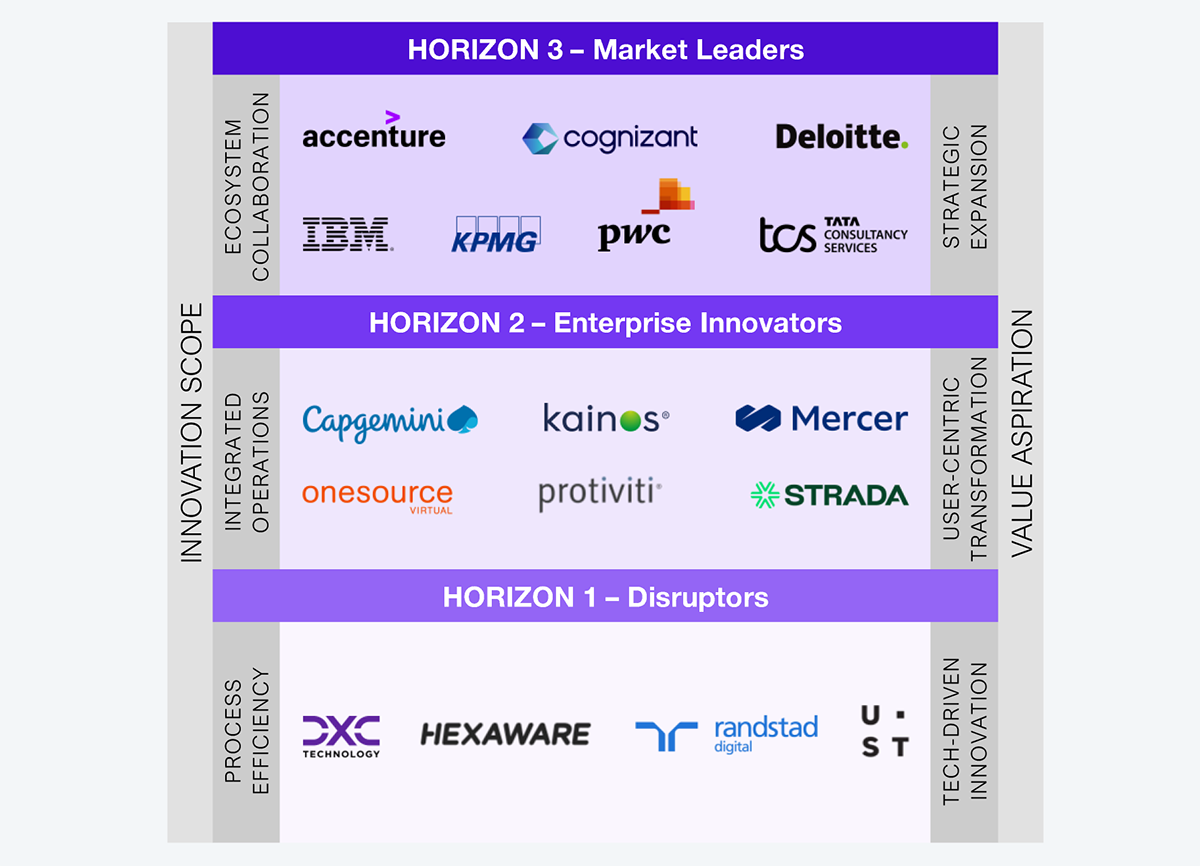CHROs, CFOs, and CIOs have spent years implementing Workday to modernize enterprise operations, but many still treat it as a technology deployment rather than a strategic foundation. Workday is more than a system of record. It sits at the center of how enterprises manage people, processes, and performance, with potential to fundamentally reshape how work gets done.
As Workday expands with analytics, automation, and AI-driven insights, the conversation must move beyond go-lives and compliance checklists toward workforce strategy, experience-led operations, and intelligent decision-making at scale. The Workday Services Horizons 2025 report shows how the ecosystem is evolving and where partners are driving the next wave of transformation.
We evaluated 17 Workday system integrator (SI) partners across three Horizons (see Exhibit 1), focusing on how service providers are helping enterprises move beyond deployments to workforce strategy, AI-enabled operations, and experience-led transformation.
The Horizons model highlights a partner ecosystem in motion. Leaders are demonstrating what full-scale transformation can look like, while innovators and disruptors are quickly maturing their capabilities to close the gap.

Source: HFS Research, 2025
Workday has become the operating backbone for many enterprises. Its unified platform brings HR, finance, and operations together with embedded analytics, automation, and AI capabilities that promise to move organizations beyond transactional efficiency toward intelligent, experience-driven business operations.
Yet most deployments remain under-ambitious. Too many programs focus on implementation milestones, integrations, and compliance rather than using Workday as a catalyst to redesign roles, orchestrate AI-enabled workflows, or create measurable workforce outcomes. Enterprise leaders said they need more from their partners: industry context, embedded innovation, and experience-led design, tying technology investments to productivity, engagement, and performance gains. They want providers that can co-create new operating models across people, finance, and technology, not just deliver software rollouts on time and on budget. Some partners are beginning to address this, but progress is still uneven.
Our assessment showed that many partners are beginning to push the limits of traditional Workday deployments. Some are leading the way by moving beyond go-lives and compliance checklists to bring industry depth, AI innovation, and measurable business outcomes into focus. The report unveiled some key findings:
Progress in the Workday ecosystem is real, but transformation will only happen if leaders keep pushing partners beyond deployments and pilots and demand:
Leaders who set this standard will position Workday as a platform for workforce strategy, intelligent operations, and measurable business outcomes, not just another system of record.
Workday’s future depends on partners that turn deployments into transformation. Partners that are shaping this future combine industry depth, AI-enabled workflows, co-innovation, and outcome-focused delivery into a single model.
The next wave of leaders will belong to those who meet their organizations’ demands for strategic guidance, ecosystem-ready solutions, and transformation at scale, not just successful go-lives. CHROs, CFOs, and CIOs are at the forefront of this shift and must insist that Workday is tied to real business outcomes, moving beyond compliance and reporting.
Register now for immediate access of HFS' research, data and forward looking trends.
Get StartedIf you don't have an account, Register here |
Register now for immediate access of HFS' research, data and forward looking trends.
Get Started